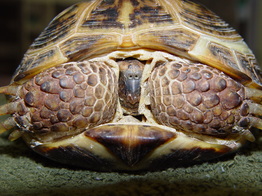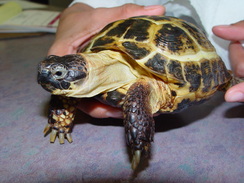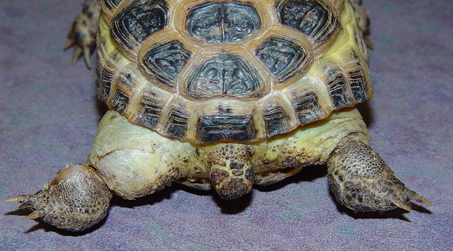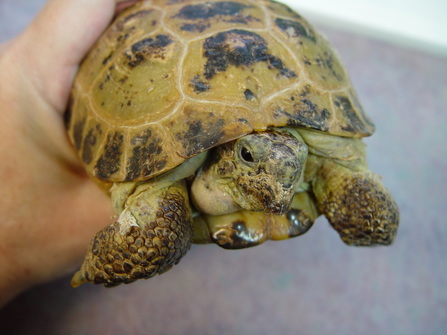Russian Tortoise Care (Agrionemys horsfieldii)
Erica Mede, CVT
Photos and edited by Susan Horton, DVM
Photos and edited by Susan Horton, DVM

Natural History
Found naturally in the dry open landscapes of Aghanistan, Pakistan, Iran, Russia, and China this tortoise is also known as the Steppe tortoise, the Afghanistan tortoise, the Russian Box Turtle, and the Four-Toed tortoise. Most Russian tortoises in the pet trade in the United States are wild caught and imported. Despite being wild caught, Russian tortoises seem to remain active, friendly, and fascinating!
Description
Russian tortoises are a small species of tortoise with a brownish to black shell that fades to a tan color closer to where the scutes connect to one another. The amount of tan varies with individuals. The plastron of the Russian tortoise is a brownish color with large dark brown to black blotches. Their thick, stocky limbs make locomotion across smooth surfaces interesting but they are adept at moving over uneven terrain. The shell length is typically between 6 and 10 inches with females being on the higher end of the range. Russian tortoises have a skin color of yellow to light brown. These tortoises are friendly and curious by nature and learn to enjoy human interaction.
Found naturally in the dry open landscapes of Aghanistan, Pakistan, Iran, Russia, and China this tortoise is also known as the Steppe tortoise, the Afghanistan tortoise, the Russian Box Turtle, and the Four-Toed tortoise. Most Russian tortoises in the pet trade in the United States are wild caught and imported. Despite being wild caught, Russian tortoises seem to remain active, friendly, and fascinating!
Description
Russian tortoises are a small species of tortoise with a brownish to black shell that fades to a tan color closer to where the scutes connect to one another. The amount of tan varies with individuals. The plastron of the Russian tortoise is a brownish color with large dark brown to black blotches. Their thick, stocky limbs make locomotion across smooth surfaces interesting but they are adept at moving over uneven terrain. The shell length is typically between 6 and 10 inches with females being on the higher end of the range. Russian tortoises have a skin color of yellow to light brown. These tortoises are friendly and curious by nature and learn to enjoy human interaction.

Enclosure
The larger the enclosure the better! Hatchlings and small juveniles can be kept in glass aquariums but will out grow them. Aquariums for adults must be large not only to offer the appropriate space needed for daily exercise and enrichment via foraging behaviors but also to allow for better air circulation. A 75-gallon aquarium or larger is suitable for most adults. Building custom enclosures with Plexi-glass, acrylic, wood, or screen is possible and allows for custom sizing. It is suggested to research “tortoise tables” on the internet for ideas on materials and dimensions. If wood is used it is recommended to seal the wood against moisture and allow it to sit for 48 hours prior to introduction of the animal. Custom cages should be around 4 feet wide by 4 feet long and 8-12 inches deep depending on the length of the tortoise.
Rubbermaid storage containers and under the bed storage boxes are extremely popular options for housing tortoises of all ages. An adult Russian tortoise can be comfortably kept in a 50-gallon Rubbermaid container. The large open tops allow for better air circulation and the rounded corners prevent escapes and make for easier cleaning. These containers are easy to clean and inexpensive to buy and can be modified to suit the tortoise’s needs. Air circulation can be improved further by cutting square or rectangular pieces from the sides and placing screening over the holes. If this method is used it is recommended to place the screening on the outside of the container to prevent sharp edges from potentially coming into contact with the tortoise.
Cage Accessories
There should be two hide boxes available for Russian tortoises. One should be positioned on the cooler side of the cage as well as the warmer side. Russians appreciate hiding places especially for their daily naps. Hide boxes can be created from cork bark half logs, half terracotta plant pots, large PVC pipes, and wooden huts. It is necessary that the tortoise be able to turn itself around in the hide area.
Rocks, drift wood, and plants (potted or fake) not only make an enclosure aesthetically pleasing to the owner, it also offers enrichment and stimulation to the tortoise. Cage accessories should be changed every week during cleaning to allow for the tortoise to explore a new surrounding which not only stimulates their minds and feeds a natural behavior but also gives them a reason to exercise. Live plants should be potted to prevent up rooting and destruction of the plants.
Water dishes should be offered not only for drinking but for soaking. Russian tortoises enjoy soaking themselves and relieving themselves in their water bowls. Daily cleaning will likely be needed. The dish should be deep enough for the tortoise to cover up to their “elbows” when standing. If a water dish deep enough for soaking cannot be provided it is recommended to soak the tortoise for 10 minutes in luke warm water 2-3 times a week.
Temperature
Russian tortoises thrive when their enclosures are kept between 70° and 80° degrees Fahrenheit during the day with a basking site reaching 95 degrees. Day time temperatures can be maintained with basking lights, under tank heaters, heat cable, and/or heat tape. It is recommended that under tank heaters, heat cable, and heat tape be monitored and maintained with a thermostat to prevent injuries such as burns. It is strongly recommended that ALL heating implements be attached to the outside of an enclosure and not inside despite the packaging claims. Placing heat cable or heat tape inside an enclosure can severely burn the tortoise. During the night, the temperature can drop as low as 70 degrees. The night time temperature should be maintained with a ceramic heat emitter or an under tank heater if needed.
Humidity
Naturally being found in drier regions with open landscapes the humidity in the enclosure should be 40-50%. The dig box of dirt being maintained as a moist dig box will have a humidity around 70% itself when the tortoise digs into it and buries itself. The moist dig box simulates the burrows Russian tortoises inhabit when humidity needs to be increased.
Lighting
Russian tortoises like all reptilian herbivores require daily exposure to UVB lighting. A 5.0 ReptiSun bulb helps prevent and correct calcium deficiency issues by simulating the effects of natural sun light. UVB lights should be on for the duration of the day light cycle which should be 12 hours a day. All UVB bulbs must be no more than 18-20 inches away from the tortoise directly overhead and no closer than 12 inches. The bulb should be replaced every 6-12 months even if it is still working to insure that the proper amount of UVB radiation is being produced.
No lighting is needed at night and is actually contraindicated. Tortoises are capable of seeing color as well as some infrared light. The use of black lights, red lights, and blue lights although marketed for reptiles can be stressful to some tortoises and should be avoided. If extra heat is needed an under tank heater or a ceramic heat emitter which gives off no light can be used.
Substrate
Reptile carpet or indoor/outdoor carpet with timothy hay on top is a great substrate for the Russian tortoise. The timothy hay offers enrichment, foraging, and a little extra toe exercise as the tortoise maneuvers over the textured terrain. The carpet underneath is an excellent barrier between the tortoise and the enclosure floor especially when under tank heaters or heat cable is used for heating the enclosure. Other substrates to consider are newspaper/newsprint and paper towel especially for the younger tortoises to monitor defecation.
Russian tortoises are known diggers and a "dig box" of just top soil (no additives) should be provided to all tortoises. Great care must be taken that the substrate in the box is kept clean and changed weekly to prevent mold and excessive bacterial growth. These boxes of dirt fulfill a natural need for the tortoise while maintaining humidity in the cage. The substrate should always be moist enough to clump together but not moist enough that excess water drains out when pressed together in an owner’s hands.
Spot cleaning of feces and uneaten food should be done daily as needed and a full substrate change done every week or as needed.
Feeding
Russian tortoises are grazers by design ingesting any dry and fresh grass, leaf, stalk, or flower they come across during their daily foraging. Their natural diet is high in fiber and low in protein. A stable diet of broad leafy plants mixed with grasses (timothy, orchard, meadow, etc) is necessary such as escarole, green leaf lettuce, red leaf lettuce, endive, romaine lettuce, turnip greens, chicory, and mustard greens. Dandelion greens tend to be a particular favorite of most tortoises. These tortoises are crepuscular which means they are the most active in the early morning and evening. Feeding should be done in the early morning.
Fruit should be avoided in the Russian tortoise diet as this is not natural to their diet. Additions of fruit can cause bloat and should be avoided. Flowers are an excellent alternative to fruit in the diet and can be offered as incentive to handling. Hibiscus, hostas, roses, and mulberry leaves are generally relished and these treats are may be taken from an owners hand when offered.
The larger the enclosure the better! Hatchlings and small juveniles can be kept in glass aquariums but will out grow them. Aquariums for adults must be large not only to offer the appropriate space needed for daily exercise and enrichment via foraging behaviors but also to allow for better air circulation. A 75-gallon aquarium or larger is suitable for most adults. Building custom enclosures with Plexi-glass, acrylic, wood, or screen is possible and allows for custom sizing. It is suggested to research “tortoise tables” on the internet for ideas on materials and dimensions. If wood is used it is recommended to seal the wood against moisture and allow it to sit for 48 hours prior to introduction of the animal. Custom cages should be around 4 feet wide by 4 feet long and 8-12 inches deep depending on the length of the tortoise.
Rubbermaid storage containers and under the bed storage boxes are extremely popular options for housing tortoises of all ages. An adult Russian tortoise can be comfortably kept in a 50-gallon Rubbermaid container. The large open tops allow for better air circulation and the rounded corners prevent escapes and make for easier cleaning. These containers are easy to clean and inexpensive to buy and can be modified to suit the tortoise’s needs. Air circulation can be improved further by cutting square or rectangular pieces from the sides and placing screening over the holes. If this method is used it is recommended to place the screening on the outside of the container to prevent sharp edges from potentially coming into contact with the tortoise.
Cage Accessories
There should be two hide boxes available for Russian tortoises. One should be positioned on the cooler side of the cage as well as the warmer side. Russians appreciate hiding places especially for their daily naps. Hide boxes can be created from cork bark half logs, half terracotta plant pots, large PVC pipes, and wooden huts. It is necessary that the tortoise be able to turn itself around in the hide area.
Rocks, drift wood, and plants (potted or fake) not only make an enclosure aesthetically pleasing to the owner, it also offers enrichment and stimulation to the tortoise. Cage accessories should be changed every week during cleaning to allow for the tortoise to explore a new surrounding which not only stimulates their minds and feeds a natural behavior but also gives them a reason to exercise. Live plants should be potted to prevent up rooting and destruction of the plants.
Water dishes should be offered not only for drinking but for soaking. Russian tortoises enjoy soaking themselves and relieving themselves in their water bowls. Daily cleaning will likely be needed. The dish should be deep enough for the tortoise to cover up to their “elbows” when standing. If a water dish deep enough for soaking cannot be provided it is recommended to soak the tortoise for 10 minutes in luke warm water 2-3 times a week.
Temperature
Russian tortoises thrive when their enclosures are kept between 70° and 80° degrees Fahrenheit during the day with a basking site reaching 95 degrees. Day time temperatures can be maintained with basking lights, under tank heaters, heat cable, and/or heat tape. It is recommended that under tank heaters, heat cable, and heat tape be monitored and maintained with a thermostat to prevent injuries such as burns. It is strongly recommended that ALL heating implements be attached to the outside of an enclosure and not inside despite the packaging claims. Placing heat cable or heat tape inside an enclosure can severely burn the tortoise. During the night, the temperature can drop as low as 70 degrees. The night time temperature should be maintained with a ceramic heat emitter or an under tank heater if needed.
Humidity
Naturally being found in drier regions with open landscapes the humidity in the enclosure should be 40-50%. The dig box of dirt being maintained as a moist dig box will have a humidity around 70% itself when the tortoise digs into it and buries itself. The moist dig box simulates the burrows Russian tortoises inhabit when humidity needs to be increased.
Lighting
Russian tortoises like all reptilian herbivores require daily exposure to UVB lighting. A 5.0 ReptiSun bulb helps prevent and correct calcium deficiency issues by simulating the effects of natural sun light. UVB lights should be on for the duration of the day light cycle which should be 12 hours a day. All UVB bulbs must be no more than 18-20 inches away from the tortoise directly overhead and no closer than 12 inches. The bulb should be replaced every 6-12 months even if it is still working to insure that the proper amount of UVB radiation is being produced.
No lighting is needed at night and is actually contraindicated. Tortoises are capable of seeing color as well as some infrared light. The use of black lights, red lights, and blue lights although marketed for reptiles can be stressful to some tortoises and should be avoided. If extra heat is needed an under tank heater or a ceramic heat emitter which gives off no light can be used.
Substrate
Reptile carpet or indoor/outdoor carpet with timothy hay on top is a great substrate for the Russian tortoise. The timothy hay offers enrichment, foraging, and a little extra toe exercise as the tortoise maneuvers over the textured terrain. The carpet underneath is an excellent barrier between the tortoise and the enclosure floor especially when under tank heaters or heat cable is used for heating the enclosure. Other substrates to consider are newspaper/newsprint and paper towel especially for the younger tortoises to monitor defecation.
Russian tortoises are known diggers and a "dig box" of just top soil (no additives) should be provided to all tortoises. Great care must be taken that the substrate in the box is kept clean and changed weekly to prevent mold and excessive bacterial growth. These boxes of dirt fulfill a natural need for the tortoise while maintaining humidity in the cage. The substrate should always be moist enough to clump together but not moist enough that excess water drains out when pressed together in an owner’s hands.
Spot cleaning of feces and uneaten food should be done daily as needed and a full substrate change done every week or as needed.
Feeding
Russian tortoises are grazers by design ingesting any dry and fresh grass, leaf, stalk, or flower they come across during their daily foraging. Their natural diet is high in fiber and low in protein. A stable diet of broad leafy plants mixed with grasses (timothy, orchard, meadow, etc) is necessary such as escarole, green leaf lettuce, red leaf lettuce, endive, romaine lettuce, turnip greens, chicory, and mustard greens. Dandelion greens tend to be a particular favorite of most tortoises. These tortoises are crepuscular which means they are the most active in the early morning and evening. Feeding should be done in the early morning.
Fruit should be avoided in the Russian tortoise diet as this is not natural to their diet. Additions of fruit can cause bloat and should be avoided. Flowers are an excellent alternative to fruit in the diet and can be offered as incentive to handling. Hibiscus, hostas, roses, and mulberry leaves are generally relished and these treats are may be taken from an owners hand when offered.
SIGNS OF A SICK TORTOISE
Tortoises are especially susceptible to respiratory ailments and nutritional deficiencies. Signs to watch for include lethargy, bubbling from the nose, wheezing, swollen or closed eyes, lack of appetite for more than 2-3 days, loose stools, soft shell or abnormal shell growth or beak growth. Pictured below is a Russian with multiple problems related to husbandry and nutrition.
Tortoises are especially susceptible to respiratory ailments and nutritional deficiencies. Signs to watch for include lethargy, bubbling from the nose, wheezing, swollen or closed eyes, lack of appetite for more than 2-3 days, loose stools, soft shell or abnormal shell growth or beak growth. Pictured below is a Russian with multiple problems related to husbandry and nutrition.
Pictured below is a Russian with infected submandibular glands. This is not to be confused with aural (ear) infections. These glands are located under the jaw. Any abnormal swellings or discharge from the nostrils or mouth should be checked out by your veterinarian right away. We have been seeing a lot of tortoise herpes in the Mediterranean tortoises lately.
Sources and Suggested Readings
Russian Tortoises (Complete Herp Care), E. J. Pirog
Pet Owner's Guide to the Tortoise, Simon J. Girling
Tortoises: A Beginner's Guide to Tortoise Care, Andrew Highfield and Nadine Highfield
If you have any questions, please feel free to call us at 847-329-8709.
Russian Tortoises (Complete Herp Care), E. J. Pirog
Pet Owner's Guide to the Tortoise, Simon J. Girling
Tortoises: A Beginner's Guide to Tortoise Care, Andrew Highfield and Nadine Highfield
If you have any questions, please feel free to call us at 847-329-8709.


